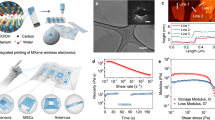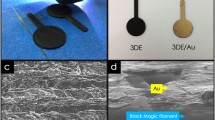Abstract
As key enablers of Industry 4.0 and Internet of Things, sensors are among the first devices which are to encounter fast physical transformation (from rigid to flexible) as of large-scale utilization of printing technologies. In order to step-up this process, adaptation of conventional fabrication technologies (based on metallization) employed in sensors’ development should be tested and demonstrated. Within this paper, we are reporting the functionality of dielectrophoresis (DEP) for electromanipulation of multi-walled carbon nanotubes (MWCNTs) as sensing element, at the level of printed interdigitated electrodes. First, we present the flatbed screen-printed process of interdigitated microelectrodes on flexible substrate with tailored geometries employed afterwards for generating convenient dielectrophoretic forces of optimal magnitude and frequency for trap** MWCNTs. Successful dielectrophoresis operability of MWCNTs across silver-based screen-printed μIDE (interdigitated microelectrodes) provided with electrode gaps of ≈ 150 μm was validated and suitable values of the signal frequencies for avoiding parasitic electrokinetic phenomena (AC electro-osmosis, electrothermal effect) occurring simultaneously with DEP were identified. Time-dependent effect of DEP over MWCNTs bridges formation is discussed, as well as voltage magnitude contribution.
Graphical Abstract








Similar content being viewed by others
Data Availability
Data sets generated during the current study are available from the corresponding author upon request.
References
Yin F, Yue W, Li Y, Gao S, Zhang C, Kan H, Niu H, Wang W, Guo Y (2021) Carbon-based nanomaterials for the detection of volatile organic compounds: a review. Carbon N Y 180:274–297. https://doi.org/10.1016/j.carbon.2021.04.080
Tang R, Shi Y, Hou Z, Wei L (2017) Carbon nanotube-based chemiresistive sensors. Sensors 17:882. https://doi.org/10.3390/S17040882
He S, Yuan Y, Nag A, Feng S, Afsarimanesh N, Han T, Mukhopadhyay SC, Organ DR (2020) A review on the use of impedimetric sensors for the inspection of food quality. Int J Environ Res Public Health 17:1–30. https://doi.org/10.3390/IJERPH17145220
Rabbani MT, Sonker M, Ros A (2020) Carbon nanotube dielectrophoresis: theory and applications. Electrophoresis 41:1893–1914. https://doi.org/10.1002/elps.202000049
Ferrier DC, Honeychurch KC (2021) Carbon nanotube (CNT)-based biosensors. Biosensors 11:1–33
Dimaki M, Bøggild P (2004) Dielectrophoresis of carbon nanotubes using microelectrodes: a numerical study. Nanotechnology 15:1095–1102. https://doi.org/10.1088/0957-4484/15/8/039
Abdulhameed A, Halim MM, Halin IA (2023) Dielectrophoretic alignment of carbon nanotubes: theory, applications, and future. Nanotechnology 34:242001. https://doi.org/10.1088/1361-6528/acc46c
Lucci M, Regoliosi P, Reale A, Di Carlo A, Orlanducci S, Tamburri E, Terranova ML, Lugli P, Di Natale C, D’Amico A, Paolesse R (2005) Gas sensing using single wall carbon nanotubes ordered with dielectrophoresis. Sensors Actuators, B Chem 111–112:181–186. https://doi.org/10.1016/j.snb.2005.06.033
Shao W, Shurin MR, Wheeler SE, He X, Star A (2021) Rapid detection of SARS-CoV-2 antigens using high-purity semiconducting single-walled carbon nanotube-based field-effect transistors. ACS Appl Mater Interfaces 13:10321–10327. https://doi.org/10.1021/acsami.0c22589
Suehiro J, Imakiire H, Hidaka SI, Ding W, Zhou G, Imasaka K, Hara M (2006) Schottky-type response of carbon nanotube NO 2 gas sensor fabricated onto aluminum electrodes by dielectrophoresis. Sensors Actuators, B Chem 114:943–949. https://doi.org/10.1016/j.snb.2005.08.043
Yun JH, Kim J, Park YC, Song JW, Shin DH, Han CS (2009) Highly sensitive carbon nanotube-embedding gas sensors operating at atmospheric pressure. Nanotechnology 20:055503. https://doi.org/10.1088/0957-4484/20/5/055503
Suehiro J, Hidaka SI, Yamane S, Imasaka K (2007) Fabrication of interfaces between carbon nanotubes and catalytic palladium using dielectrophoresis and its application to hydrogen gas sensor. Sensors Actuators B Chem 127:505–511. https://doi.org/10.1016/J.SNB.2007.05.002
Al-Diabat AM, Algadri NA, Ahmed NM, Abuelsamen A, Bidier SA (2021) A high-sensitivity hydrogen gas sensor based on carbon nanotubes fabricated on SiO2 substrate. Nanocomposites 7:172–183. https://doi.org/10.1080/20550324.2021.1977063
Suehiro J, Zhou G, Imakiire H, Ding W, Hara M (2005) Controlled fabrication of carbon nanotube NO2 gas sensor using dielectrophoretic impedance measurement. Sensors Actuators, B Chem 108:398–403. https://doi.org/10.1016/j.snb.2004.09.048
Inaba M, Oda T, Kono M, Phansiri N, Morita T, Nakahara S, Nakano M, Suehiro J (2021) Effect of mixing ratio on NO2 gas sensor response with SnO2-decorated carbon nanotube channels fabricated by one-step dielectrophoretic assembly. Sensors Actuators, B Chem 344:130257. https://doi.org/10.1016/j.snb.2021.130257
Xue W, Li P (2011) Dielectrophoretic deposition and alignment of carbon nanotubes. Carbon Nanotubes - Synthesis. Characterization, Applications, pp 171–190
Abdulhameed A, Halin IA, Mohtar MN (2021) pH-sensing characteristics of multi-walled carbon nanotube assembled across transparent electrodes with dielectrophoresis. IEEE Sens J 21:26594–26601
Abdulhameed A, Halin IA, Mohtar MN, Hamidon MN (2021) Airflow-assisted dielectrophoresis to reduce the resistance mismatch in carbon nanotube-based temperature sensors. RSC Adv 11:39311–39318. https://doi.org/10.1039/d1ra08250g
Tran VT, Wei Y, Liau WJ, Yang H, Du H (2017) Preparing of interdigitated microelectrode arrays for AC electrokinetic devices using inkjet printing of silver nanoparticles ink. Micromachines 8:106. https://doi.org/10.3390/mi8040106
Challier L, Lemarchand J, Deanno C, Jauzein C, Mattana G, Mériguet G, Rotenberg B, Noël V (2021) Printed dielectrophoretic electrode-based continuous flow microfluidic systems for particles 3D-trap**. Part Part Syst Charact 38:1–11. https://doi.org/10.1002/ppsc.202000235
Wee WH, Li Z, Hu J, Kadri NA, Xu F, Li F, **guan-Murphy B (2015) Fabrication of dielectrophoretic microfluidic chips using a facile screen-printing technique for microparticle trap**. J Micromech Microeng 25:105015. https://doi.org/10.1088/0960-1317/25/10/105015
Abdulhameed A, Mohtar MN, Hamidon MN, Mansor I, Halin IA (2021) Characterization and selective deposition of carbon nanotubes from carbon nanoparticles mixture using mild acid treatment and electrokinetic manipulation. Mater Res Express 8:055603. https://doi.org/10.1088/2053-1591/ac017e
Zhou T, Kropp E, Chen J, Kulinsky L (2020) Step-wise deposition process for dielectrophoretic formation of conductive 50-micron-long carbon nanotube bridges. Micromachines 11:371
Abdulhameed A, Abdul Halin I, Mohtar MN, Hamidon MN (2020) The role of medium on the assembly of carbon nanotube by dielectrophoresis. J Dispers Sci Technol 41:1576–1587. https://doi.org/10.1080/01932691.2019.1631841
Kinio S, Mills JK (2016) Design of optimal electrode geometries for dielectrophoresis using fitness based on simplified particle trajectories. Biomed Microdevices 18:1–15. https://doi.org/10.1007/S10544-016-0085-8/TABLES/1
Abdulhameed A, Halin IA, Mohtar MN, Hamidon MN (2022) The role of the electrode geometry on the dielectrophoretic assembly of multi-walled carbon nanotube bundles from aqueous solution. J Electrostat 116:103694. https://doi.org/10.1016/j.elstat.2022.103694
Filip TA, Turcan I, Scarlatache VA, Dragomir A, Olariu MA (2022) Electric field numerical modeling and simulation of V-shaped interdigitated microelectrodes. In: 2022 International Conference on Engineering and Emerging Technologies (ICEET), Kuala Lumpur, Malaysia, pp 1–4. https://doi.org/10.1109/ICEET56468.2022.10007144
Ramos A, Morgan H, Green NG, Castellanos A (1998) Ac electrokinetics: a review of forces in microelectrode structures. J Phys D Appl Phys 31:2338–2353. https://doi.org/10.1088/0022-3727/31/18/021
Wong PK, Wang TH, Deval JH, Ho CM (2004) Electrokinetics in micro devices for biotechnology applications. IEEE/ASME Trans Mechatronics 9:366–376. https://doi.org/10.1109/TMECH.2004.828659
Oh J, Hart R, Moses H (2009) Comprehensive analysis of particle motion under non-uniform AC electric fields in a microchannel †. Lab Chip 9:62–78. https://doi.org/10.1039/b801594e
Abdulhameed A, Mohtar MN, Hamidon MN, Mansor I, Halin IA (2021) The role of the AC signal on the dielectrophoretic assembly of carbon nanotubes across indium tin oxide electrodes. Microelectron Eng 247:111597. https://doi.org/10.1016/j.mee.2021.111597
Cui L, Holmes D, Morgan H (2001) The dielectrophoretic levitation and separation of latex beads in microchips. Electrophoresis 22:3893–3901. https://doi.org/10.1002/1522-2683(200110)22:18%3c3893::AID-ELPS3893%3e3.0.CO;2-2
Chen Q, Cao Z, Yuan YJ (2020) Study on non-bioparticles and: Staphylococcus aureus by dielectrophoresis. RSC Adv 10:2598–2614. https://doi.org/10.1039/c9ra05886a
An L, Friedrich CR (2008) Real-time gap impedance monitoring of dielectrophoretic assembly of multiwalled carbon nanotubes. Appl Phys Lett 92:173103. https://doi.org/10.1063/1.2918016
Oliva-Avilés AI, Alonzo-García A, Zozulya VV, Gamboa F, Cob J, Avilés F (2018) A dielectrophoretic study of the carbon nanotube chaining process and its dependence on the local electric fields. Meccanica 53:2773–2791. https://doi.org/10.1007/s11012-018-0869-4
Acknowledgements
This study is supported by a grant of the Romanian Ministry of Research, Innovation and Digitization, CNCS—UEFISCDI, project number PN-III-P1-1.1-TE-2021-0751, within PNCDI III.
Author information
Authors and Affiliations
Corresponding author
Ethics declarations
Competing interests
The authors declare no competing interests.
Additional information
Publisher's Note
Springer Nature remains neutral with regard to jurisdictional claims in published maps and institutional affiliations.
Supplementary Information
Below is the link to the electronic supplementary material.
Supplementary file2 (MP4 7427 KB)
Supplementary file3 (MP4 7425 KB)
Supplementary file4 (MP4 7434 KB)
Rights and permissions
Springer Nature or its licensor (e.g. a society or other partner) holds exclusive rights to this article under a publishing agreement with the author(s) or other rightsholder(s); author self-archiving of the accepted manuscript version of this article is solely governed by the terms of such publishing agreement and applicable law.
About this article
Cite this article
Olariu, M.A., Filip, T.A., Peptu, C.A. et al. Screen-printed interdigitated microelectrodes employment in dielectrophoretic manipulation of MWCNTs. Microchim Acta 190, 453 (2023). https://doi.org/10.1007/s00604-023-06023-3
Received:
Accepted:
Published:
DOI: https://doi.org/10.1007/s00604-023-06023-3




